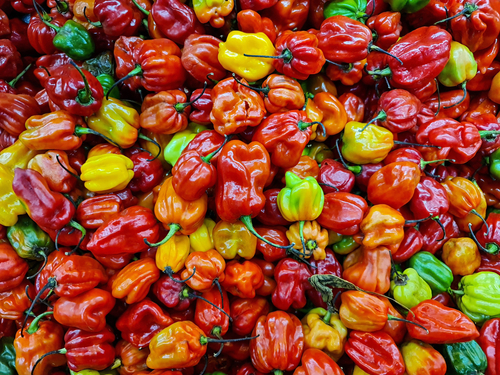The scotch bonnet pepper is fundamental to Caribbean cooking. It’s a key ingredient in dishes like jerk chicken, pepper sauces, soups, and stews, offering a combination of bright fruitiness and fiery heat. But outside of the islands, it can sometimes be hard to find.
Just as Remitly helps friends and family stay connected across borders, familiar foods can bring the essence of home when you live abroad. If scotch bonnet is hard to find where you are, don’t worry—there are some simple and practical alternatives to this celebrated pepper.
In this article, we’ll review the best scotch bonnet substitutes—like habaneros, milder fresh chilis, and additional ingredients—and share tips on how to use them to bring your Caribbean cooking to life. Whether you’re an experienced chef, a Caribbean native living abroad, or just someone interested in the flavors and colors of the Caribbean, we can help you bring a taste of the islands to your kitchen.
What makes scotch bonnet peppers special?
Scotch bonnet peppers have become a defining ingredient in Caribbean cuisine for a reason.
One of the first things you notice is the heat. Ranging from 100,000 to 350,000 Scoville heat units, these peppers have a similar spice level to habaneros but with a unique flavor. The fruity undertone to the heat gives them an almost tropical sweetness, often compared to apricot, apple, or even tomato.
Because of their unique flavor, scotch bonnets are more than just a way to spice up your dishes. Their balanced heat and fruitiness bring unique depth to curries, stews, and marinades, making them almost a true icon of Caribbean cooking.
When you can’t find scotch bonnet peppers
Scotch bonnet peppers trace their origins to the Amazon region of South America, before being cultivated throughout the Caribbean. They need a lot of heat and sunshine to grow, which makes them relatively easy to cultivate in the Caribbean but less common as a commercial crop in cooler climates. In places like the US or Europe, scotch bonnet is generally imported, and it may be less common in local grocery stores.
Even in places where scotch bonnet is available, you still might want to switch it for something else. Sometimes, you might want a milder heat level than scotch bonnet can provide, and some of these substitutions can give you exactly that.
With the right ingredients, you can maintain the authenticity and vibrant flavor of Caribbean food even without scotch bonnet peppers.
Best substitutes for scotch bonnet peppers
Habaneros
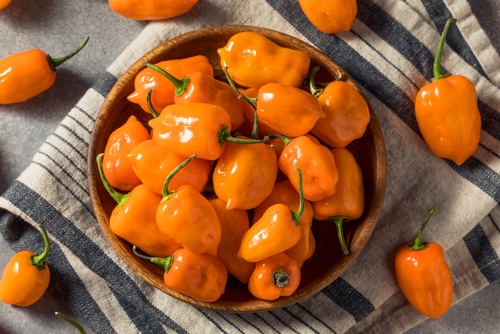
Habanero peppers are probably the closest match to scotch bonnets. These peppers have a similar heat level and belong to the same pepper family. They also have some of that fruity flavor the scotch bonnet is known for, though they tend to be sharper and less sweet.
Habaneros are used across Central and South America, so they can slide easily into lots of different recipes without changing the flavor profile too much.
When using habaneros in recipes, it’s a good idea to start with smaller amounts than the recipe calls for, as it’s easier to add more heat if you need it than to take it away when it’s too much. Habaneros work beautifully in marinades, stews, and pepper sauces, making them perhaps the most practical substitute for scotch bonnets.
Thai chili peppers
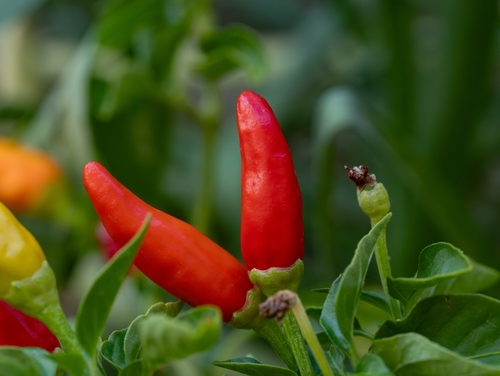
A Thai chili pepper gives you plenty of spiciness. They can reach 100,000 Scoville units—less than scotch bonnets but still able to pack a punch.
These peppers can help preserve the bold heat of classic Caribbean dishes, but they tend to be sharper and biting rather than fruity. Blending them with a sweeter pepper, like a red bell pepper or a mini sweet pepper, can give you that balance of heat and fruitiness that’s characteristic of jerk marinades and pepper sauces.
Ghost peppers
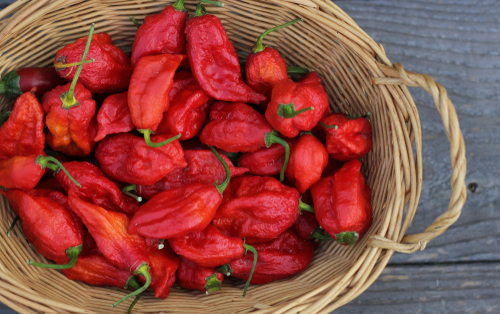
If you need a serious kick in your food, the bhut jolokia, commonly known as the ghost pepper, can give you all the heat you need. These furious peppers measure over one million Scoville units, making them far hotter than even the hottest scotch bonnet. Ghost peppers do have a slight fruitiness to them, but really, it’s the heat that tends to dominate.
If you use them as a substitute for the scotch bonnet, be careful! As they are so much hotter, you’ll want to use tiny amounts. Just a couple of slivers of ghost pepper can be enough to overpower a whole dish, so you’ll have to balance flavors carefully to stop that ferocious heat from overwhelming everything else.
To bring out more of the sweetness and tame the heat a little bit, you could combine these peppers with bell peppers, carrots, or even fruit juice. That way, you can get both heat and depth without the spice becoming too much.
Fresno chili peppers
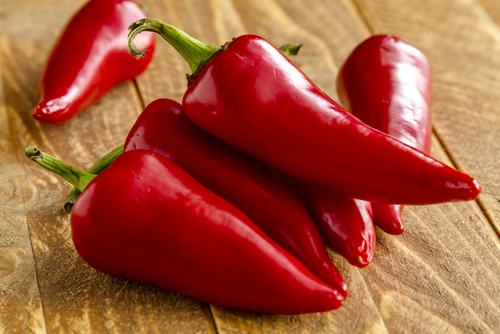
Fresno chili peppers are a great option if you want the flavor of a scotch bonnet without all the heat. They clock in at around 2500 to 10,000 Scoville units, which makes them closer to a jalapeño level of spiciness. They come with a bright flavor and a subtle sweetness that works well in Caribbean cooking, and are one of the milder scotch bonnet substitutions out there.
If fresno peppers are too mild for you, pair them with some hot sauce or chili flakes. This helps balance sweet and heat in true Caribbean style.
Bell peppers with chili powder or cayenne
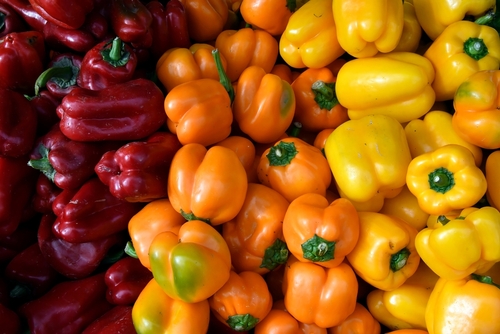
Bell peppers are available just about everywhere. These bright vegetables add a sweetness and freshness to countless dishes, making them incredibly versatile. What they don’t have is heat—but if you find you miss it, you can add it back in with a dash of chili powder or cayenne.
Try a ratio of one large bell pepper, blended or chopped, mixed with 1/4 teaspoon of cayenne, or half a teaspoon of chili powder. You can adjust the ratio to suit your own tastes. This is a good workaround for anyone who can’t handle the heat of scotch bonnets.
Jalapeños
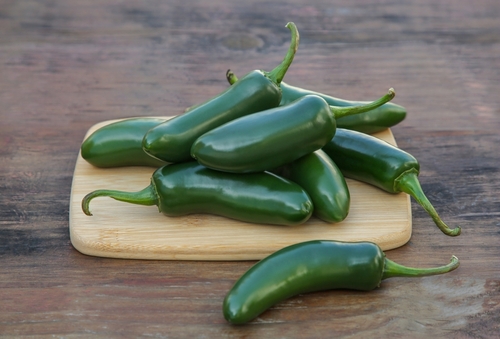
Jalapeños don’t pack the same punch as a scotch bonnet, but they are typically more widely available. They have a fresh, grassy flavor that can work well in a sauce or a stew. At around 2500 to 8000 Scoville units, they do have a bit of heat, so they can be great if you want to tone down the heat of Caribbean cooking a little bit but still keep a good amount of flavor.
Of course, if Jalapeños aren’t hot enough for you, a dash of hot sauce can help enhance the spice. Pairing them with sweeter peppers like red bell peppers helps to bring sweetness closer to the flavor profile of the scotch bonnet.
Here’s a table to summarize the substitutes we’ve talked about:
| Substitute | Scoville heat units (SHU) | Flavor notes | Best use cases |
| Habanero | 100,000–350,000 | Fruity, tropical, very similar to scotch bonnet | Jerk marinades, pepper sauces, curries |
| Thai chili | 50,000–100,000 | Sharp, biting heat, less fruity | Curries, sauces, blended with sweet peppers |
| Ghost pepper (bhut jolokia) | 1,000,000+ | Earthy, slightly fruity, extremely hot | For heat lovers. Use sparingly in sauces/stews. |
| Fresno chili | 2,500–10,000 | Mild, slightly sweet, bright flavor | A milder everyday substitute; works in sauce and marinades |
| Bell pepper + cayenne | 0–500 (bell) + spice added | Sweet, fruity, with adjustable heat from cayenne | Low-heat curries, sauces, stews |
| Jalapeño | 2,500–8,000 | Fresh, grassy, mildly spicy | Everyday substitute; pair with sweet peppers |
Pro tips for substituting effectively
Finding a substitute for the scotch bonnet isn’t just about availability. Switching to some of these replacement ideas can give you more control over the spice level of your food, though bear in mind that they can also affect the flavor profile.
- Adjust heat levels: Start small, especially if you’re using hotter peppers like habaneros or ghost peppers. Remember, you can always add more spice later.
- Balance the flavors: Scotch bonnets aren’t just about heat. They also bring a distinctive fruity flavor that you’ll need to replicate. Sharper alternatives like Thai chilies or milder replacements like jalapeños can be balanced with sweet bell peppers, allspice, or even fruit juices (orange or pineapple work well).
- Taste as you go: Check flavors at each stage. Adjusting early helps you correct seasoning before it’s too late.
- Test small portions: Before you add an untested ingredient to a full pot of stew or marinade you’ve been working on for a while, try it in a smaller portion. This way, you can fine-tune the heat and flavor without risking the whole dish.
Keeping it authentic
Creating authentic Caribbean food is about more than just one particular ingredient. Scotch bonnets play a central role, but staples like thyme, allspice, scallions, and garlic provide the vibrant foundation for the unmistakable flavor of Caribbean dishes. When you get those right, even a substitute pepper can deliver a dish that tastes true to its roots.
Another option is to use a hot sauce or paste made from scotch bonnet. These products tend to have a longer shelf life than the fresh peppers, so they are often more readily available. Check out Caribbean markets, international aisles in grocery stores, or shop online to see what you can get your hands on.
Scotch bonnet substitutes to bring Caribbean food to life
Scotch bonnet peppers are a key part of many Caribbean dishes, but with a little creativity and adaptability, you can still make amazing food without them.
Experimenting with other types of pepper and sources of heat lets you create something new and uniquely your own. You can fuse the tropical flavors of the Caribbean with a more Asian or South American twist and make something that is both authentic and creative at the same time.
Plus, replacing scotch bonnet peppers lets you adapt the heat level of your dishes. This is ideal for people who can’t handle the full fire of traditional recipes but still want to experience the complex flavors of Caribbean cooking.
Part of the joy of cooking is making things yourself, so don’t be afraid to experiment with some of these scotch bonnet pepper substitutes—you can still honor Caribbean flavor while adapting to your kitchen.
FAQs
What’s the closest substitute for scotch bonnet peppers?
The closely-related habanero pepper is the nearest substitute for a scotch bonnet when it comes to the combination of heat and fruity flavor. However, they don’t have the same sweetness, and they’re a bit sharper than scotch bonnets.
How can I tone down the heat when using substitutes?
Some substitutes, like ghost peppers, may be even hotter than the scotch bonnet. Use fewer peppers, remove seeds and membranes, and balance your scotch bonnet alternative with mild ingredients like bell peppers to get closer to that classic taste.
Can I use dried scotch bonnets if I can’t find fresh ones?
Yes, dried scotch bonnets work well as a substitute for fresh ones. Their flavor is slightly deeper and smokier than fresh, but they have a longer shelf life. Scotch bonnet-based hot sauces and pastes can also make a more practical alternative when you can’t get the fresh pepper.
How do I add a touch of scotch bonnet flavor without the heat?
Use a milder pepper. You could also mix them with sweeter base ingredients to balance the heat. Bell peppers, carrots, or even fruit juice can all take the edge off the scotch bonnet’s famous heat.
